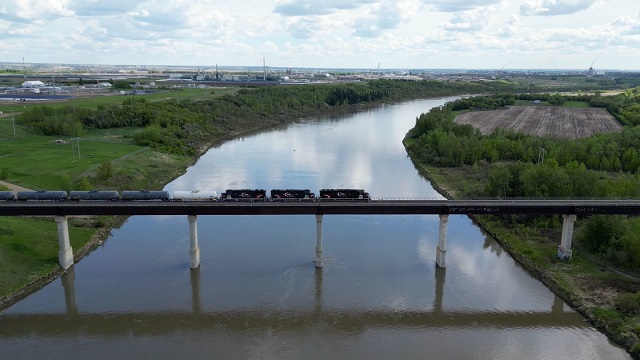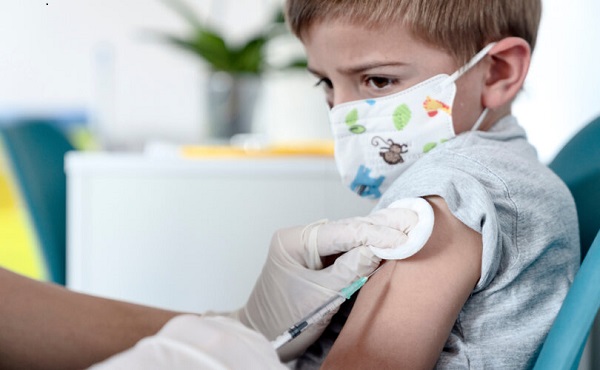Alberta
Alberta rail hub doubling in size to transport plastic from major new carbon-neutral plant

Haulage bridge at Cando Rail & Terminals’ Sturgeon Terminal in Alberta’s Industrial Heartland, near Edmonton. Photo courtesy Cando Rail & Terminals
From the Canadian Energy Centre
By Will Gibson
Cando Rail & Terminals to invest $200 million to support Dow’s Path2Zero petrochemical complex
A major rail hub in Alberta’s Industrial Heartland will double in size to support a new carbon-neutral plastic production facility, turning the terminal into the largest of its kind in the country.
Cando Rail & Terminals will invest $200 million at its Sturgeon Terminal after securing Dow Chemical as an anchor tenant for its expanded terminal, which will support the planned $8.9 billion Path2Zero petrochemical complex being built in the region northeast of Edmonton.
“Half of the terminal expansion will be dedicated to the Dow project and handle the products produced at the Path2Zero complex,” says Steve Bromley, Cando’s chief commercial officer.
By incorporating carbon capture and storage, the complex, which began construction this spring, is expected to be the world’s first to produce polyethylene with net zero scope 1 and 2 emissions.
The widely used plastic’s journey to global markets will begin by rail.
“Dow stores their polyethylene in covered railcars while waiting to sell it,” Bromley says.
“When buyers purchase it, we will build unit trains and those cars will go to the Port of Prince Rupert and eventually be shipped to their customers in Asia.”
A “unit train” is a single train where all the cars carry the same commodity to the same destination.
The expanded Cando terminal will have the capacity to prepare 12,000-foot unit trains – or trains that are more than three-and-a-half kilometers long.
Construction will start on the expansion in 2025 at a 320-acre site west of Cando’s existing terminal, which 20 industrial customers use to stage and store railcars as well as assemble unit trains.
Bromley, a former CP Rail executive who joined Cando in 2013, says the other half of the terminal’s capacity not used by the Dow facility will be sold to other major projects in the region.
The announcement is the latest in a series of investments for Cando to grow its operations in Alberta that will see the company spend more than $500 million by 2027.
The company, which is majority owned by the Alberta Investment Management Corporation previously spent $100 million to acquire a 1,700-railcar facility in Lethbridge along with $150 million to build its existing Sturgeon terminal.
Cando Rail’s existing Sturgeon Terminal near Edmonton, Alberta. Photo courtesy Cando Rail & Terminals
“Alberta is important to us – we have 300 active employees in this province and handle 900,000 railcars annually here,” Bromley says.
“But we are looking for opportunities across North America, both in Canada and the United States as well.”
Cando released the news of the Sturgeon Terminal expansion at the Alberta Industrial Heartland Association’s annual conference on Sept. 19.
“This is an investment in critical infrastructure that underpins additional growth in the region,” says Mark Plamondon, the association’s executive director.
The announcement came as the association marked its 25th anniversary at the event, which Plamondon saw as fitting.
“Dow’s Path2Zero came to the region because of the competitive advantages gained by clustering heavy industry. Competitive advantages are built from infrastructure that’s already here, such as the Alberta Carbon Trunk Line, which transports and stores carbon dioxide for industry,” he says.
“Having that level of integration can turn inputs into one operation into outputs for another. Competitive advantages for one become advantages for others. Cando’s investment will attract others just as Dow’s Path2Zero was a pull for additional investment.”
Alberta
On gender, Alberta is following the science

Despite falling into disrepute in recent years, “follow the science” remains our best shot at getting at the truth of the physical sciences.
But science, if we are to place our trust in it, must be properly defined and understood; it is at its essence an ever-changing process, a relentless pursuit of truth that is never “settled,” and one that is unafraid to discard old hypotheses in the face of new evidence.
And it is in this light—in the unforgiving glare of honest science—that Alberta Premier Danielle Smith’s three new legislative initiatives around gender policy are properly understood, notwithstanding the opprobrium they’ve attracted from critics.
Bill 26, the Health Statutes Amendment Act, proposes to prohibit the prescription of puberty blockers and cross-gender hormones for the treatment of gender dysphoria to youth aged 15 and under. It would allow minors aged 16 and 17 to begin puberty blockers and hormone therapies for gender “reassignment” and “affirmation” purposes only with parental, physician, and psychologist approval. The bill also prohibits health professionals from performing sex reassignment surgeries on minors.
Bill 27, the Education Amendment Act, seeks to enshrine parents’ rights to be notified if their kids change their names/pronouns at school, and it gives parents the right to “opt in” to what sort of gender and sex education their kids are exposed to in school.
And Bill 29, the Fairness and Safety in Sports Act, is designed to protect females in sports by ensuring that women and girls can compete in biological female-only divisions, while supporting the formation of co-ed opportunities to support transgender athletes.
Each of these initiatives is entirely reasonable, given what we know of the science underpinning “gender care,” and of the undeniable advantages that a male physique confers upon biological males competing in sports.
The notion that the trifecta of puberty blockers, cross-gender hormones, and revisionist surgery is a pathway to good health was a hypothesis initially devised by Dutch researchers, who were looking to ease the discomfort of transgender adults struggling with incongruence between their physical appearance and their gender identities. As a hypothesis, it was perhaps reasonable.
But as the UK’s Cass Review exposed in withering detail last spring, its premises were wholly unsupported by evidence, and its implementation has caused grievous harm for youth. As Finnish psychiatrist Riittakerttu Kaltiala, one of the architects of that country’s gender program, put it last year, “Gender affirming care is dangerous. I know, because I helped pioneer it.”
It’s no accident, then, that numerous European jurisdictions have pulled back from the “gender affirming care” pathway for youth, such as Sweden, Finland, Belgium, the Netherlands, and the United Kingdom.
It makes perfect sense that Canadians should be cautious as well, and that parents should be apprised if their children are being exposed to these theories at school and informed if their kids are caught up in their premises.
Yet the Canadian medical establishment has remained curiously intransigent on this issue, continuing to insist that the drug-and-surgery-based gender-affirming care model is rooted in evidence.
Premier Smith was asked by a reporter last month whether decisions on these matters aren’t best left to discussions between doctors and their patients; to which she replied:
“I would say doctors aren’t always right.”
Which is rather an understatement, as anyone familiar with the opioid drug crisis can attest, or as anyone acquainted with the darker corners of medical history knows: the frontal lobotomy saga, the thalidomide catastrophe, and the “recovered memories of sexual abuse” scandal are just a few examples of where doctors didn’t “get it right.”
As physicians, we advocate strongly for self-regulation and for the principle that medical decisions are private matters between physicians and patients. But self-regulation isn’t infallible, and when it fails it can be very much in the interests of the public—and especially of patients—for others to intervene, whether they be journalists, lawyers, or political leaders.
The trans discussion shouldn’t be a partisan issue, although it certainly has become one in Canada. It’s worth noting that Britain’s freshly elected Labour Party chose to carry on with the cautious approach adopted by the preceding administration in light of the Cass Review.
Premier Smith’s new polices are eminently sensible and in line with the stance taken by our European colleagues. None of her initiatives are “anti-trans.” Instead, they are pro-child, pro-women, and pro-athlete, and it’s difficult to see how anyone can quibble with that.
Dr. J. Edward Les, MD, is a pediatrician in Calgary, senior fellow at the Aristotle Foundation for Public Policy, and co-author of Teenagers, Children, and Gender Transition Policy: A Comparison of Transgender Medical Policy for Minors in Canada, the United States, and Europe.
Alberta
Alberta mother accuses health agency of trying to vaccinate son against her wishes

From LifeSiteNews
Alberta Health Services has been accused of attempting to vaccinate a child in school against his parent’s wishes.
On November 6, Alberta Health Services staffers visited Edmonton Hardisty School where they reportedly attempted to vaccinate a grade 6 student despite his parents signing a form stating that they did not wish for him to receive the vaccines.
“It is clear they do not prioritize parental rights, and in not doing so, they traumatize students,” the boy’s mother Kerri Findling told the Counter Signal.
During the school visit, AHS planned to vaccinate sixth graders with the HPV and hepatitis B vaccines. Notably, both HPV and hepatitis B are vaccines given to prevent diseases normally transmitted sexually.
Among the chief concerns about the HPV vaccine has been the high number of adverse reactions reported after taking it, including a case where a 16 year-old Australian girl was made infertile due to the vaccine.
Additionally, in 2008, the U.S. Food and Drug Administration received reports of 28 deaths associated with the HPV vaccine. Among the 6,723 adverse reactions reported that year, 142 were deemed life-threatening and 1,061 were considered serious.
Children whose parents had written “refused” on their forms were supposed to return to the classroom when the rest of the class was called into the vaccination area.
However, in this case, Findling alleged that AHS staffers told her son to proceed to the vaccination area, despite seeing that she had written “refused” on his form.
When the boy asked if he could return to the classroom, as he was certain his parents did not intend for him to receive the shots, the staff reportedly said “no.” However, he chose to return to the classroom anyway.
Shortly after, he was called into the office and taken back to the vaccination area. Findling said that her son then left the school building and braved the sub-zero temperatures to call his parents.
Following his parents’ arrival at the school, AHS claimed the incident was a misunderstanding due to a “new hire,” attesting that the mistake would have been caught before their son was vaccinated.
“If a student leaves the vaccination center without receiving the vaccine, it should be up to the parents to get the vaccine at a different time, if they so desire, not the school to enforce vaccination on behalf of AHS,” Findling declared.
Findling’s story comes just a few months after Alberta Premier Danielle Smith promised a new Bill of Rights affirming “God-given” parental authority over children.
A draft version of a forthcoming Alberta Bill of Rights provided to LifeSiteNews includes a provision beefing up parental rights, declaring the “freedom of parents to make informed decisions concerning the health, education, welfare and upbringing of their children.”
-

 Brownstone Institute4 hours ago
Brownstone Institute4 hours agoThe Most Devastating Report So Far
-

 Economy16 hours ago
Economy16 hours agoCOP 29 leaders demand over a $1 trillion a year in climate reparations from ‘wealthy’ nations. They don’t deserve a nickel.
-

 Alberta14 hours ago
Alberta14 hours agoOn gender, Alberta is following the science
-

 Energy15 hours ago
Energy15 hours agoOttawa’s proposed emission cap lacks any solid scientific or economic rationale
-

 Bruce Dowbiggin3 hours ago
Bruce Dowbiggin3 hours agoCHL Vs NCAA: Finally Some Sanity For Hockey Families
-

 Brownstone Institute1 day ago
Brownstone Institute1 day agoFirst Amendment Blues
-

 Crime2 days ago
Crime2 days agoMexican cartels are a direct threat to Canada’s public safety, and the future of North American trade
-

 Business2 days ago
Business2 days agoDEI gone?: GOP lawmakers prep to clean house in federal government





